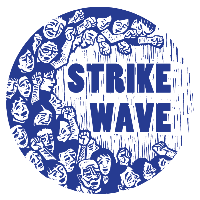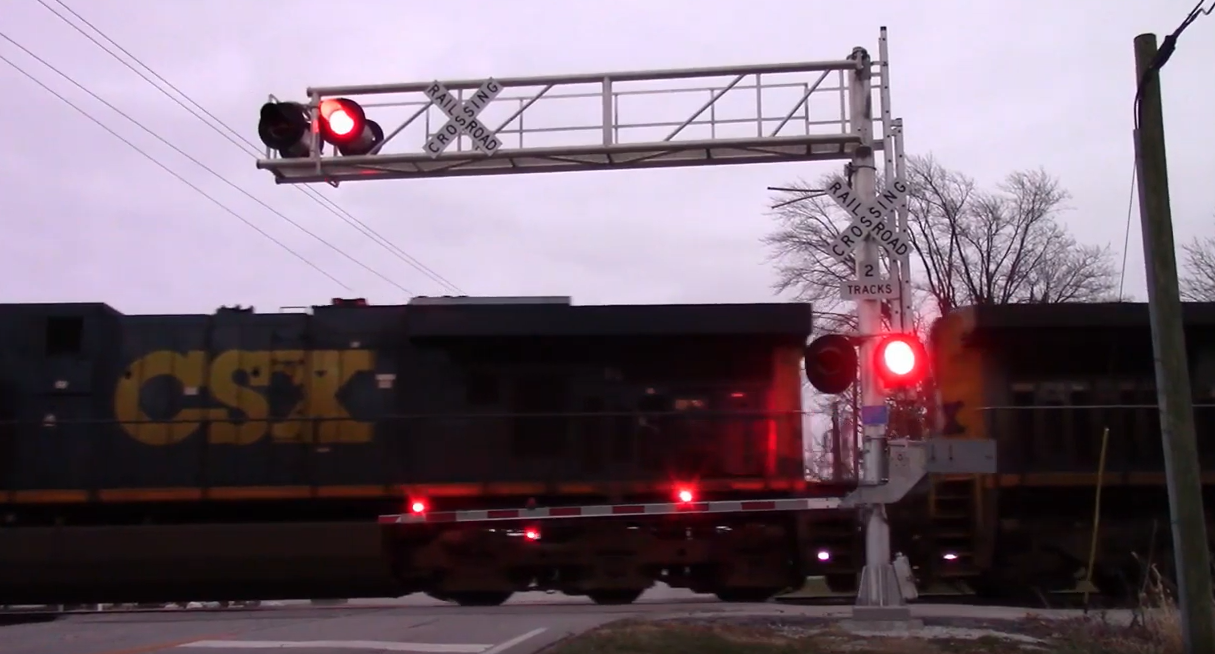End of the Line: US Railroaders Come Down to the Wire
By Max Belasco
Switzer Siding in South Raub, Indiana. Source: GMF Train Videos
Kenneth Edwards lives two miles away from Switzer Siding, a stretch of rail line adjacent to the main freighter rail line south of Lafayette, Indiana. The siding was constructed in 2015 to allow freight trains pass each other, clearing the freight traffic that would come from nearby Indianapolis and the heavily congested Chicago trainyards. Or at least it would clear traffic, according to Edwards, if the freight trains were not too long to use the siding.
“They’ve got like 800 feet that they could take off that train and then that train would fit [in the siding] and it wouldn’t block any crossing,” says Edwards. “But they gotta put that 800 feet on there every time.”
Switzer Siding crosses County Road 800 South, which becomes inaccessible for lengths of time whenever freight train blockages occur. As part of the local neighborhood watch that observes the crossing, Edwards attests those blockages are frequent. “And guess what? There’s two schools on the other side of that crossing, and they’ve had janitors in there watching kids because teachers were stuck on the other side, blocked by the train. School buses had to turn around, and so kids miss school.”
Being forced to wait as a result of the train carriers is not a new experience for Edwards. A locomotive engineer and member of the Sheet Metal, Air, Rail, and Transportation Workers (SMART-TD), he along with 140,000 other railroad workers have been at the bargaining table since 2020 with the National Carriers Conference Committee (NCCC), the body representing the major freight rail carriers.
Railroad workers are not covered under the National Labor Relations Act, and instead are governed by the Railway Labor Act (RLA), a law passed in 1924 and amended in 1934 and 1936 and is the United States’ first federal collective bargaining law. When negotiations reached an impasse this year, the RLA mandated a “cool down” period of 30 days before any labor action could be taken. After those 30 days the Biden Administration intervened with a mediation body called the Presidential Emergency Board (PEB), a right afforded to the administration under the RLA. This led to 30 days of waiting for the PEB to provide recommendations, and another 30 day “cool down” period for the recommendations to be considered.
Even this morning as tonight’s deadline to strike a deal looms over the US supply chain, the Biden Administration has stepped in once again to arrange a tentative agreement. How the membership will receive that agreement, made between the carriers and the railroad unions after 20 hours of deliberation, remains to be seen.
But for many railroaders, this strike is an opportunity to reverse decisions made by the freight carriers decades ago that they believe are crippling the U.S. rail system. Decisions with consequences that, like a five-mile freight train making its way across the countryside, were a long time coming.
A Misnomer and a Farce
Many of the railroad workers’ demands can be traced directly to decisions made by the carriers nearly 30 years ago. One of those decisions was the switch among major carriers to “Precision Scheduled Railroading,” or PSR.
PSR is a concept first introduced by Illinois Central Railroad by its then-CEO in 1993. Prior to its introduction, trains were not dispatched unless they met a specific capacity of cargo. Once they reached an adequate amount of cargo they would be sent to a specific location to deliver their goods. Under PSR, trains are not sent out based on capacity but by a specific schedule that train yards have to meet regardless of how much the train is carrying. Fewer trains are idle and more trains are now constantly moving. The idea was intended, as Union Pacific puts it, to “streamline operations” and “benefit customers by providing consistent, reliable, predictable service.”
“PSR is a farce,” says Nick Greficz, a train conductor and SMART-TD member operating out of Detroit, Michigan. From his perspective PSR has only created a draconian scheduling system that is followed to the detriment of service and worker well-being. “It’s supposed to have everything on a strict timeline but what it’s done is the opposite. Just to get the car out of the yard that’s scheduled to go to Montana they’ll first send it over to Florida.”
In addition to unnecessary freight trips being scheduled, Greficz also notes that this has led to trains increasing rapidly in length. “Say you run three trains out of Los Angeles – one goes to Texas, the other to Nevada, and the other to Oregon. What PSR does is instead of sending three 10,000 ft-long trains to those locations, they send one 30,000 ft long train that leaves at 3 PM and goes to all of those locations.” Instead of leading to smaller train lines as promised, single miles-long freight lines are created that are expected to follow a tight schedule along a wide swathe of states and cities.
Ron Kaminkow, a locomotive engineer based out of Nevada and a member of the Brotherhood of Locomotive Engineers and Trainmen (BLET), has some other words for PSR:“It’s the biggest misnomer in history.”
In addition to expanding the length of freight trains, Kaminkow notes how the increased length also leads to more possibilities for an accident. “The rail industry has buggered up the goddamn supply of the railroads in this country so bad with their big ass stupid trains that it’s very hard to expedite traffic.” Kaminkow estimates that the downtime for repairing train cars has doubled, a fact that’s exacerbated by the fact that most U.S. main freight lines are single track. “Unless you happen to have broken down right where a siding is, where trains can run around you, you have everything blocked.”
Despite the promise of PSR to keep efficient routes with constantly moving freight trains, and a noted decline of overall US freight volume that even the major rail carriers acknowledge, the actual length of train cars has increased from 2008 to 2017, according to a 2019 report on rail safety put out by the US Government Accountability Office. That same report also mentions that the congestion caused by these long freight trains has had significant impacts on emergency response times – including areas in the Midwest like south of Lafayette.
A Self-Imposed Manpower Shortage
The increased length of freight trains under PSR creates a number of logistical nightmares and safety hazards, all of which is exacerbated by the gradual decline of available crew members. A Surface Transportation Board hearing from April 26th and 27th saw all parties, railroad unions and carriers alike, acknowledge the labor shortage. For railroaders, however, the labor shortage seems artificially created by the carriers. This seems all the more apparent as the railroad unions have faced resistance to their demand of “two person crews.”
“There used to be six, five people back on the trains in the eighties and they pared it down to two people on the train,” says Greficz. Having seen PSR at work for 18 years, he has seen how the lack of raises has caused rapid attrition in the number of available railroaders. That combined with the strenuous system PSR has gnawed away at one of the benefits of being a railroader – the downtime. “If you had your kid’s birthday party or you were just tired or you needed the day off to pay bills or go to the doctors, you could do that because there were enough people to cover vacancies if you didn’t want to work that day. But now in this PSR crunch there’s not resources or employees available.” The lack of available railroaders has only made PSR scheduling a nonstop workload, causing sick leave to become a major bargaining issue.
Rail carriers like Norfolk Southern have argued that advances in technology – particularly the development of Positive Train Control (PTC) – have rendered the role of a conductor as a second crewmember unnecessary. Kaminkow, however, remembers hearing arguments for single crew freight trains before PTC was even mandated in 2008. “For those of us who are in the industry and before PTC was even a distant dream in 2004, the rail carriers were trying to get the unions to agree to let the carriers run trains with a single employee,” Kaminkow recalls. “It’s an opportunistic argument that they’re making to just do something that they were already planning on doing.”
Even with PTC on trains, Kaminkow maintains it is still dangerous to only have one crew member on freight trains – particularly with so much of the United States freight lines being single-rail. “If you were to slip and fall or in any way get hurt, have a heart attack, you’re pretty much done for because nobody’s going to know, right?” Another important aspect of the job, Kaminkow asserts, is how unlike long-haul truck drivers the operators of a freight train are often in remote areas away from other vehicles that can provide assistance when trouble arises. “You’re often not in cell phone range, there are no shoulders to park on and call for help, there are no truck stops where you can get a cup of coffee.”
Where attrition due to PSR and reduced salaries has not properly reduced crew numbers, Greficz has noted in his capacity as his local’s chairperson that grievances have also dramatically increased over the years. “The tactics that they’re using is basically putting paper on everybody for what used to be considered minor safety violations. You didn’t have safety glasses on, you weren’t wearing a vest, not to mention they changed all the attendance policies.” Greficz has said that “people with 10, 15, 20 years are now walking off the job. And this is all part of the self-imposed manpower shortage.”
“We’re Not Going to Accept Less”
As of this morning, the Biden Administration announced that it was able to reach a tentative agreement with BLET and SMART-TD after 20 hours of negotiations. Businesses reliant on freight rail had been begging the White House to intervene – an administration that is facing a midterm election in a couple months.
That said, tentative agreements are exactly that – tentative. They still require a vote by the union membership to be ratified. It is unclear whether or not the membership, who had been waiting for this moment, will take the deal. No matter how many media figures or politicians want to weigh in on the situation, the fight is not over until that vote has been finalized.
What is certain is that many of the railroaders are prepared to not settle for anything less than what essential workers deserve. Ken Edwards, the locomotive engineer from Indiana, is prepared to strike for both SMART-TD and BLET members alike. “We owe it to our people to give them the contract that they deserve. They missed birthdays, they missed weddings, they worked their asses off. So we’re not going to accept less.”
Max Belasco is a member of UPTE-CWA and a member of the Strikewave Editorial Collective

